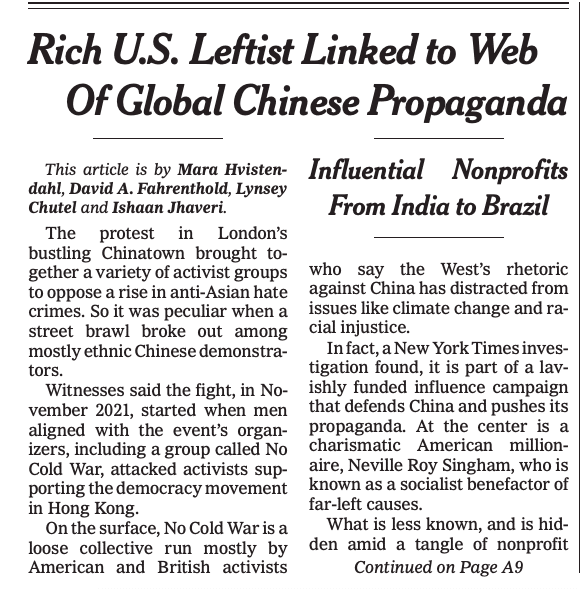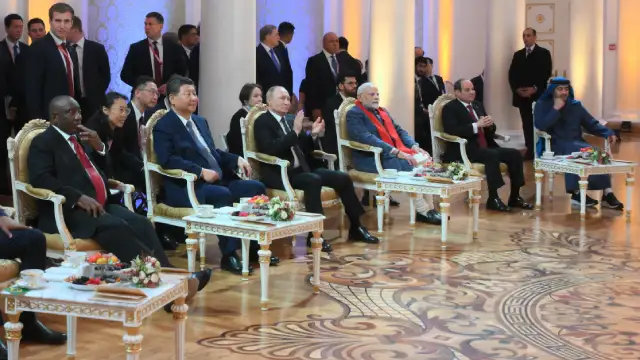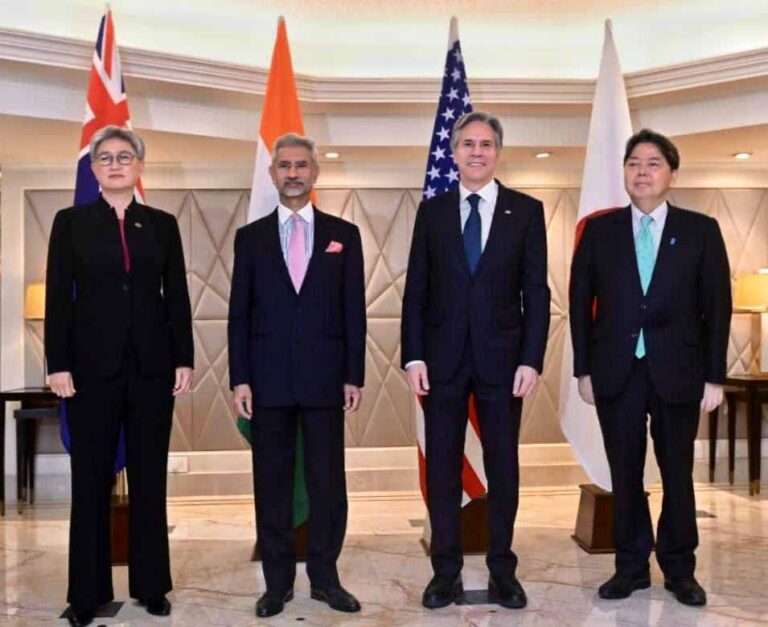Exhibiting the traits of McCarthyism, the New York Times (NYT) has published a scathing attack on Neville Roy Singham, an American entrepreneur. The NYT’s article on Singham titled “A Global Web of Chinese Propaganda Leads to a U.S. Tech Mogul”, written by Mara Hvistendahl, David A Fahrenthold, Lynsey Chutel and Ishaan Jhaveri, accused him of being an apparatchik of the Communist Party of China (CPC) and highlights such problems that need immediate attention.

The New York Times article on Neville Roy Singham on the front page of the newspaper on August 5th. This article launched a smearing campaign against Singham and US non-profits allegedly linked to him.
Spanning over 3,000 words, the long essay levelled several accusations against Singham, who is known for his left-wing thoughts. It alleged that Singham has been working at the behest of the CPC and is using a network of US-based non-profit foundations to sponsor political activism and media outlets to carry out Chinese propaganda.
However, the NYT’s article on Singham has several loopholes and appears to have no credible evidence to back its allegations. Several activists and organisations have condemned the article’s findings and it’s worth having a look at the fallacy that has been highlighted by the critics of the US mainstream media.
Who all are named by the NYT’s article on Singham?
The NYT article on Singham’s Chinese link named organisations like Code Pink, Tricontinental Institute for Social Research, No Cold War, etc, as those funded by Beijing to run its political propaganda.
It also alleged that a South African school, a news portal and the Socialist Revolutionary Workers Party—which it called “fringe”—have received donations from Singham’s non-profit bodies.
The NYT’s article on Singham also accused an Indian news portal named NewsClick of carrying out Chinese propaganda.
The portal, which has been on the radar of Prime Minister Narendra Modi’s far-right Bharatiya Janata Party (BJP) government for critical reporting, has been fighting a legal battle since 2021.
The article also named several other organisations and activists, including Singham’s wife Jodie Evans.
An allegation with no evidence
“China has expanded state media operations, teamed up with overseas outlets and cultivated foreign influencers. The goal is to disguise propaganda as independent content”
While the basics of investigative journalism demand that journalists present facts and data that are sourced from authentic documents, the NYT article on Singham’s alleged links with the CPC’s propaganda division didn’t take that route.
Though the article claimed that donations worth over US$ 275m are involved in these so-called Chinese propaganda operations it didn’t give any details. It rather blamed the opacity that remains over the identity of the donors of US-based foundations.
“Because American nonprofit groups do not need to disclose individual donors, these four nonprofits worked like a financial geyser, throwing out a shower of money from an invisible source”, the writers wrote to recuse themselves from proving their allegations.
Rather than carrying out an in-depth investigation to reveal the “invisible source”, they went on to describe how Singham was seen with senior Chinese officials in Beijing, and that he attended some meetings of the CPC.
The writers merely used data available in the public domain, including photographs, to prove that he was working as a Chinese mouthpiece!
The NYT’s article on Singham also claimed that he routed $1.8m to a Chinese company named Maku, with which he shares office space in Shanghai.
If Singham has been taking money from China for carrying out the CPC’s propaganda, why would he pay the Chinese?
Moreover, the article used rhetoric to stir Sinophobia. What the NYT found objectionable in Singham’s work is his left-leaning ideological standpoint and opposition to the US foreign policy that has been promoting wars throughout the world since 1945.
“He and his allies are on the front line of what Communist Party officials call a ‘smokeless war.’ Under the rule of Xi Jinping, China has expanded state media operations, teamed up with overseas outlets and cultivated foreign influencers. The goal is to disguise propaganda as independent content”, the article said.
The writers didn’t reveal though how they got to know that the “goal” is to “disguise propaganda as independent content”? It’s not clear whether they managed to get secret Chinese documents that mentioned it. No such authentic document has been produced by the NYT.
Lacking evidence, the writers picked up everything that they can present as circumstantial evidence to prove their case. Singham running a YouTube channel to educate the people about China’s impressive growth and poverty alleviation has been one such evidence.
Singham’s crimes
The NYT’s article on Singham’s alleged connection with the Chinese has listed several incidents to connect the dots. Here is a list of incidents from the NYT’s article on Singham’s alleged CPC connection (excerpts from the article):
1. Support for Chinese socialism
“Mr. Singham has long admired Maoism, the Communist ideology that gave rise to modern China. He praised Venezuela under the leftist president Hugo Chávez as a ‘phenomenally democratic place.’ And a decade before moving to China, he said the world could learn from its governing approach (sic)”.
Now, Singham isn’t the only one to praise the Chinese government’s poverty alleviation programme. Several prominent academicians, activists, politicians and economists from all over the world, including the US, have shared positive reviews regarding the “Chinese story”.
Chavez, an iconic left-wing leader whose rule in Venezuela freed the country from the US’s neo-colonial occupation, has also won laurels of fame throughout the Global South. It’s not unusual for anyone to appreciate him.
Singham’s statement on the world learning from the Chinese experience of governance isn’t unfounded.
“Mr. Singham has long admired Maoism, the Communist ideology that gave rise to modern China.”
Unlike the US, China has alleviated poverty in its country and lifted nearly 800m people out of sheer poverty, according to a World Bank press statement. However, poverty has been growing in the US due to the concentration of wealth in fewer hands and widening income disparity.
China’s infrastructure development has left the US back by several years, as it has modernised its high-speed railway system and built a chain of highways throughout its territory. The US has no high-speed railway system, while China has around 35,000km of high-speed network. While 70% of Chinese routes are electrified, the US could barely electrify only 2% of its routes.
Unlike the US, where at least 5.1% of the population is most likely to go to prison in a lifetime, China has a relatively lower incarceration rate and higher conviction rate. While the US, which is far behind China in terms of population, has 2,068,800 prisoners, ie, 629 people per 100,000, China has 1,690,000 prisoners, ie, 119 people per 100,000. The US houses 25% of the world’s prisoners.
2. Not taking credit for donations
“While other moguls slapped their names on foundations, Mr. Singham sent his money through a system that concealed his giving (sic).”
It’s Singham’s prerogative if he didn’t want to earn fame through his philanthropic activities. He didn’t use it as a marketing tool alike other American oligarchs who fund the two parties of the ultra-rich in the country that share power on a rotating basis. Is it a crime in the US to not brag about donations?
3. Sponsoring media and political movements
“The Times tracked money to a South African political party, YouTube channels in the United States and nonprofits in Ghana and Zambia. In Brazil, records show, money flowed to a group that produces a publication, Brasil de Fato, that intersperses articles about land rights with praise for Xi Jinping (sic).”
Singham’s sponsoring of political parties and publications didn’t result in the growth of terrorism, so-called “colour revolutions” or riots in those countries. However, funding from US-based non-profits like Rockefeller Foundation or those that come from American oligarch George Soros have been used in toppling elected governments and sponsoring violent uprisings in different countries.
4. Funding NewsClick in India
“It has become a routine practice with the present government to deploy government-controlled agencies to deal with all those who disagree with and criticise the government.”
Prabir Purkayastha, Editor-in-Chief, NewsClick
“In New Delhi, corporate filings show, Mr. Singham’s network financed a news site, NewsClick, that sprinkled its coverage with Chinese government talking points. ‘China’s history continues to inspire the working classes,’ one video said (sic).”
Media outlets like NewsClick have been defending the concept of the free press in India, which has reportedly come under attack from Modi’s far-right, Hindutva-driven BJP.
In February 2021, India’s federal anti-money laundering agency Enforcement Directorate (ED) raided the office and residences of senior officials of the NewsClick portal. The portal alleged that the ED raid was a result of its unbiased coverage of people’s news, which has irked the present dispensation.
“It has become a routine practice with the present government to deploy government-controlled agencies to deal with all those who disagree with and criticise the government. In the past, the income tax department, the ED, various Central investigative agencies like the Central Bureau of Investigation and National Investigation Agency, have been selectively used in this manner against a range of people – from journalists to political leaders, to even farmers’ leaders”, the portal had said in its statement in 2021.
By blowing a dog whistle on NewsClick, which is already fighting a legal battle against the government’s allegations, the NYT’s article on Singham helped India’s far-right rulers to widen their net of witch hunting.
The allegations in the article, which lack evidence that can prove that Chinese money entered NewsClick will now help the government to expand the crackdown on other such media houses, an act that even bothered the NYT at one point in time, and further curtail the freedom of speech.
5. Sharing office space with a Chinese company in China
“He shares the office with a Chinese media company called Maku Group, which says its goal is to ‘tell China’s story well,’ a term commonly used for foreign propaganda. In a Chinese-language job advertisement, Maku says it produces text, audio and videos for ‘global networks of popular media and progressive think tanks.’ (sic)”
Sharing an office with a Chinese company in China, which adheres to Chinese laws and rules, isn’t a crime. Major US corporations like Google, Microsoft, Ford Motor Company, etc, have offices in China and they follow the local regulations and laws, which are directed by the CPC. That doesn’t make them CPC agents.
Apart from these, the NYT’s article on Singham accuses him of running a YouTube programme, accused Evans of organising anti-war movements in the US, accused them of downplaying the US propaganda over “Uighyur genocide” in China’s Xinjiang, which even the Islamic countries don’t recognise, and of publishing news and promoting political movements that oppose the US’s foreign policy.
The article started by citing an article published in the New Lines Magazine, which is published by Washington DC-based Newlines Institute for Strategy and Policy, which declares on its website that it is “working to enhance U.S. foreign policy based on a deep understanding of the geopolitics of the different regions of the world and their value systems (sic)”.
This indicates where the NYT’s interests lie.
Criticism of the NYT’s report on Singham
“I categorically deny and repudiate any suggestion that I am a member of, work for, take orders from, or follow instructions of any political party or government or their representatives”.
Neville Roy Singham
Singham had denied the allegations against him. The NYT’s report on Singham quotes his statement saying, “I categorically deny and repudiate any suggestion that I am a member of, work for, take orders from, or follow instructions of any political party or government or their representatives”.
“I am solely guided by my beliefs, which are my long-held personal views”, the report quoted him saying.
“We do not and have never received funds or instructions from any government or political party”, Vijay Prashad, the executive director of the Tricontinental Institute of Social Research told the writers in response to their question on CPC funding.
“The allegations being made against us by certain political actors and sections of the media are unfounded and without basis in fact or law”, Prabir Purkayastha, the editor-in-chief of NewsClick wrote in a statement.
“Newsclick is an independent news organisation, and any insinuation that we function as a mouth-piece of the Communist Party of China or other interests is false. We reiterate our faith in the Indian Courts, and are confident that Newsclick has, and continues to function in accordance with Indian law (sic)”, Purkayastha wrote.
“Influential media outlets like The New York Times have joined right-wing extremists in using intimidation tactics to silence these advocates for change, affecting not only the left but everyone who supports free speech and democratic rights.”
The statement by the organisations and individuals against the NYT report
Several organisations and individuals have condemned the NYT’s article on Singham. A statement signed by over 60 individuals and over 12 organisations accused the NYT of using the “Red Scare” template used by the infamous Republican senator Joseph (“Joe”) Raymond McCarthy in the 1950s to persecute left-leaning intellectuals, organisations and activists in the US, accusing them of being Soviet spies.
The McCarthy-era repression didn’t spare the most popular Americans of the time, including Charlie Chaplin, WEB Du Bois, Eugene Debs, Emma Goldman, Paul Robeson and Martin Luther King Jr.
“As the US government grapples with a major crisis of legitimacy, it has grown fearful of young people becoming conscious and organized to change the world. Influential media outlets like The New York Times have joined right-wing extremists in using intimidation tactics to silence these advocates for change, affecting not only the left but everyone who supports free speech and democratic rights (sic)”, the statement said.
“Media outlets have tried to scandalize funding sources of several organizations that are on the frontlines working with anti-racist, feminist, anti-war, abolitionist, climate justice, and other movements throughout the United States and globally. Meanwhile, when white neoliberal philanthropists flood the non-profit complex with significant funds to support their political agendas this is rarely scrutinized or made accountable to the communities they impact”, the statement further said.
A threat to global peace movements
The NYT’s article on Singham indicates that the American oligarchs have trained their guns on anti-war, anti-imperialist and pro-democracy forces around the world who don’t subscribe to the US foreign policy.
To demean them and to delegitimise their voices, the US establishment and the American oligarchs are using Russophobia and Sinophobia in abundance.
With the allegations—sans evidence—levelled against the organisations and publications, especially NewsClick that operates from a country like India with increasing press censorship, the NYT’s article on Singham not only resurrected the spirit of McCarthyism but also provided enough ammunition to oligarchs and the global right-wing to carry out extensive witch hunt in different countries and suppress the voice of dissent.
India’s Union Information and Broadcasting Minister Anurag Thakur, who once raised genocidal slogans targeting the minority Muslims, used the NYT article on Singham to lambast the opposition.
Thakur accused the Indian National Congress (INC), its parliamentarian Rahul Gandhi and the Communist Party of India (CPI) of being Chinese agents. However, the NYT report on Singham didn’t even name the INC, CPI or Gandhi.
This phenomenon, set in motion by the NYT, is an indication of a very dark phase of press censorship and curtailment of human rights that the West has been planning to unleash on the world with the help of far-right actors.
It’s to be seen whether the West can succeed now in achieving its goal or whether the people’s discontent against its neo-colonialism will be able to undo the damage.
Tanmoy Ibrahim is a journalist who writes extensively on geopolitics and political economy. During his two-decade-long career, he has written extensively on the economic aspects behind the rise of the ultra-right forces and communalism in India. A life-long student of the dynamic praxis of geopolitics, he emphasises the need for a multipolar world with multilateral ties for a peaceful future for all.







